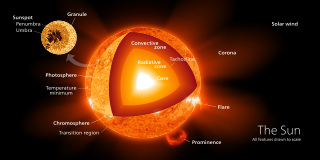
The core of the Sun is considered to extend from the center to about 0.2 of the solar radius (139,000 km; 86,000 mi).[1] It is the hottest part of the Sun and of the Solar System. It has a density of 150,000 kg/m3 (150 g/cm3) at the center, and a temperature of 15 million kelvins (15 million degrees Celsius; 27 million degrees Fahrenheit).[2]
The core is made of hot, dense plasma (ions and electrons), at a pressure estimated at 26.5 million gigapascals (3.84×1012 psi) at the center.[3] Due to fusion, the composition of the solar plasma drops from 68 to 70% hydrogen by mass at the outer core, to 34% hydrogen at the center.[4]
The core contains 34% of the Sun's mass, but only 3% of the Sun's volume, and it generates 99% of the fusion power of the Sun. There are two distinct reactions in which four hydrogen nuclei may eventually result in one helium nucleus: the proton–proton chain reaction – which is responsible for most of the Sun's released energy – and the CNO cycle.
- ^ García, Rafael A.; Turck-Chièze, Sylvaine; Jiménez-Reyes, Sebastian J.; et al. (15 June 2007). "Tracking Solar Gravity Modes: The Dynamics of the Solar Core". Science. 316 (5831): 1591–1593. Bibcode:2007Sci...316.1591G. doi:10.1126/science.1140598. ISSN 0036-8075. PMID 17478682. S2CID 35285705.
- ^ "NASA/Marshall Solar Physics". NASA.gov. Archived from the original on 2019-03-29. Retrieved 2015-07-09.
- ^ "Sun Fact Sheet". NASA Space Science Data Coordinated Archive.
- ^ E. Gary, Dale. "Solar System Astronomy Lecture 22". New Jersey Institute of Technology.